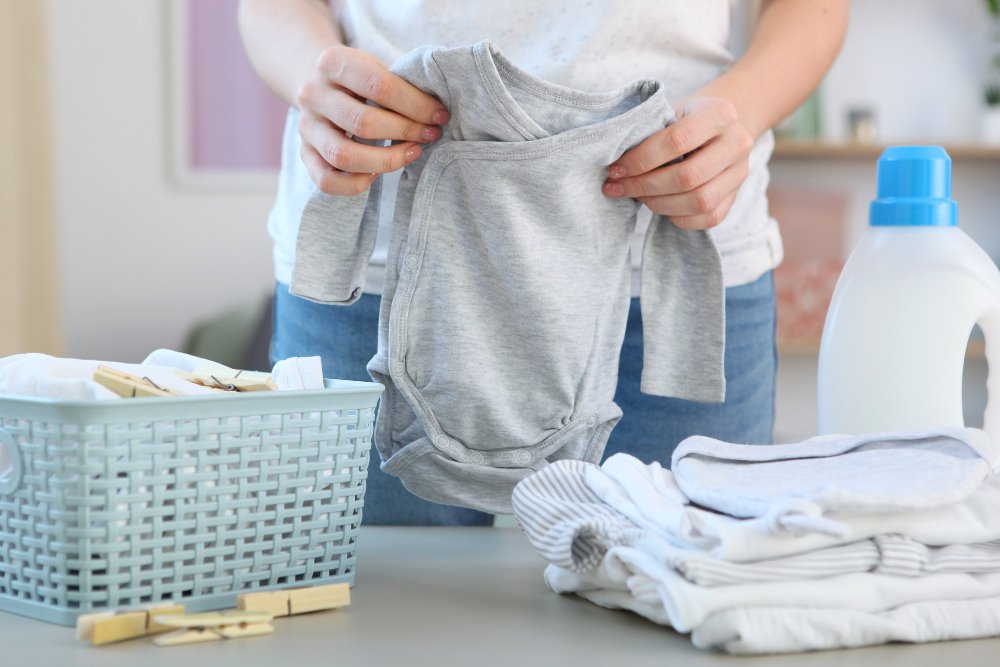The Complete 2025 Guide to Washing Every Fabric Type: From Cotton to Silk, Master Proper Textile Care
Taking care of your clothes properly helps them last longer and look better. Every fabric needs different care, from gentle washing for delicate silks to regular machine washing for sturdy cottons. The right way to wash any fabric is to check its care label first and use the right water temperature, washing method, and detergent for that specific material.
Proper fabric care saves money by making clothes last longer. When you wash fabrics correctly, they keep their shape, color, and texture. This means fewer replacements and better-looking clothes over time.
Table of Contents
Quick Answer: Essential Fabric Care Tips
- Always read care labels before washing
- Sort by both fabric type and color
- Use appropriate water temperatures
- Choose the right wash cycle for each fabric
- Never mix dry-clean-only items with regular laundry
💡 Need personalized help? Use our interactive Fabric Care Calculator to get specific washing instructions for any fabric type, or try our Stain Removal Guide for step-by-step troubleshooting.
Understanding Different Fabric Types
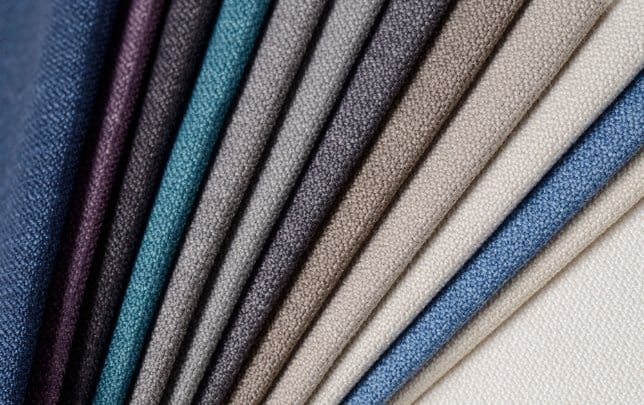
Fabrics fall into three main groups based on their fiber content. Each type has unique properties that affect how they feel, perform, and need to be cared for.
Natural Fibers
Cotton remains one of the most popular natural fabrics for everyday clothing and household items. It offers excellent breathability and comfort. Cotton can handle regular machine washing and responds well to warm water and standard detergents.
Wool requires special care and should be dry cleaned seasonally to maintain its shape and quality. It provides warmth and naturally repels water. Most wool items need gentle handling to prevent felting and shrinkage.
Silk is delicate yet strong. It requires gentle washing in cool water to preserve its lustrous appearance. Many silk garments benefit from professional cleaning.
Linen resists dirt and provides excellent cooling properties. It wrinkles easily but becomes softer with each wash. Linen can shrink significantly, so proper pre-treatment is essential.
Synthetic Fibers
Polyester stands out for its durability and wrinkle resistance. It dries quickly and holds its shape well during washing. Most polyester items can handle regular machine washing with warm water.
Nylon offers exceptional strength and elasticity. It resists damage from oils and many chemicals. Nylon items typically wash well in cool water on gentle cycles.
Activewear typically uses lycra or spandex, which provide stretch and moisture-wicking properties. These fabrics need special care to maintain their elasticity.
Acrylic mimics wool’s warmth but costs less and proves easier to care for. It can usually handle machine washing with regular detergent.
Blended Fabrics
Cotton-polyester blends combine comfort with durability. They resist wrinkles better than pure cotton while maintaining breathability. These blends typically follow cotton care guidelines.
Wool-synthetic blends offer warmth with improved washability and reduced cost compared to pure wool. Care instructions usually lean toward the more delicate fiber.
Spandex blends add stretch to many fabrics, improving comfort and fit retention. Always use gentle cycles and cool water to preserve elasticity.
Common blend ratios include 60/40 or 50/50 splits between natural and synthetic fibers.
Reading and Interpreting Care Labels
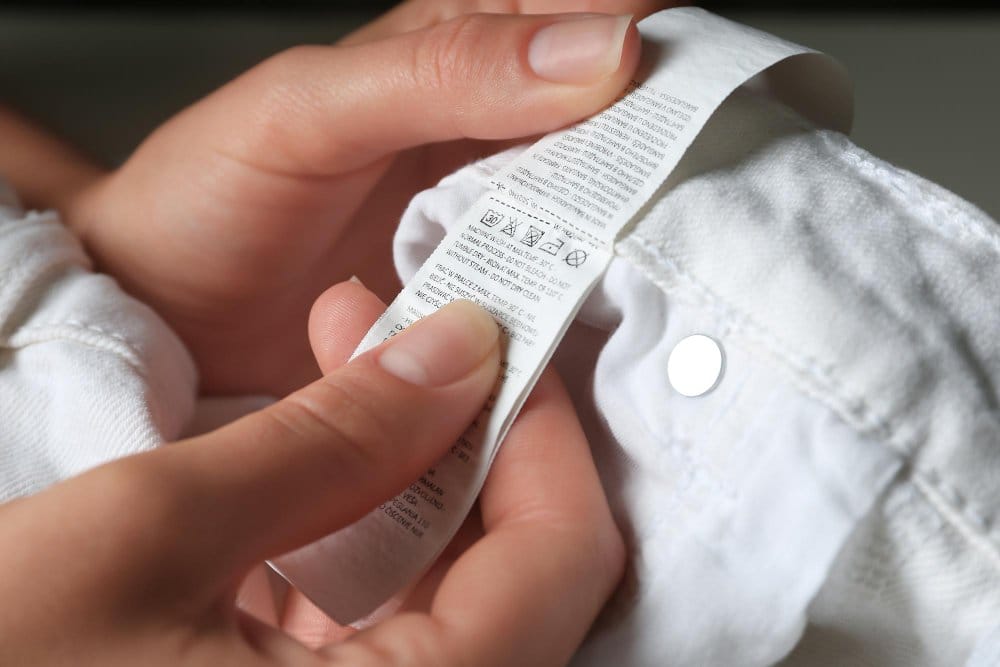
Care labels contain vital instructions for keeping clothes in good condition. These small tags use universal symbols to show how to wash, dry, iron, and bleach garments properly.
The washing symbol looks like a washtub with water. Numbers inside the symbol indicate the maximum water temperature in Celsius. Lines underneath mean gentle or delicate cycles should be used.
Proper fabric care starts with understanding drying symbols. A square with a circle inside represents tumble drying, while dots indicate heat settings – one dot for low heat, two for medium, three for high.
The American Cleaning Institute emphasizes that proper understanding of care symbols can extend garment life significantly when followed consistently. Taking time to decode these symbols before washing prevents costly damage and helps maintain your clothing investment.
Common Care Symbol Guide
| Symbol | Meaning |
|---|---|
| Triangle | Bleaching instructions |
| Iron | Pressing temperature guidelines |
| Circle | Dry cleaning requirements |
| Square | Drying methods |
| Washtub | Washing instructions |
When using laundry detergent, check if the label specifies hand washing or machine washing. Some delicate fabrics may need special gentle detergents. If you’re confused by the symbols on your garment labels, our Care Symbol Decoder provides instant explanations for any care symbol you encounter.
Professional dry cleaning symbols appear as a circle. If the circle has an X through it, the item should not be dry cleaned.
The American Cleaning Institute offers educational video content explaining fabric care symbols, which can be found on their official website and social media channels. Visual demonstrations make it easier to remember these important symbols.
Fabric Care Emergency Guide

What to do when things go wrong:
Shrinkage Recovery
If an item shrinks, try soaking it in lukewarm water with hair conditioner for 30 minutes. Gently stretch while damp and lay flat to dry.
Color Bleeding Fix
For minor bleeding, rewash immediately in cold water. For severe bleeding, try a color remover product designed for textiles.
Pilling Removal
Use a fabric shaver or sweater comb to remove pills gently. Work in one direction to avoid further damage.
Quick Problem-Solving Tools
When fabric care emergencies arise, having the right guidance at your fingertips makes all the difference:
- Unknown fabric type? Our Fabric Care Calculator helps identify the best care approach for any material
- Mysterious stain? Follow our Interactive Stain Removal Guide for targeted treatment steps
- Confusing care labels? Use our Care Symbol Decoder to understand exactly what each symbol means
Pre-Wash Best Practices
Pre-washing fabrics prevents shrinkage and removes excess dyes. Testing fabrics first helps avoid damaged garments and color bleeding.
Colorfastness and Sorting
Test colorfastness by placing a damp white cloth on an inconspicuous area of the fabric. If color transfers, wash the fabric separately.
Dark and light fabrics need separate washing to prevent color bleeding. Sort fabrics by weight too – delicate fabrics should not be washed with heavy materials.
Place loosely woven or delicate fabrics in mesh bags before washing. This protects them from tangling or stretching.
Pre-treating Stains
Examine fabrics carefully for spots or stains before pre-washing. Apply appropriate stain removers to marked areas.
Common Pre-treatment Methods:
- Gentle blotting with cool water
- Spot cleaning with mild detergent
- Using fabric-specific stain removers
Let pre-treatments sit for 10-15 minutes before washing. For delicate fabrics, test stain removers on a small hidden area first.
How to Wash Different Types of Fabrics
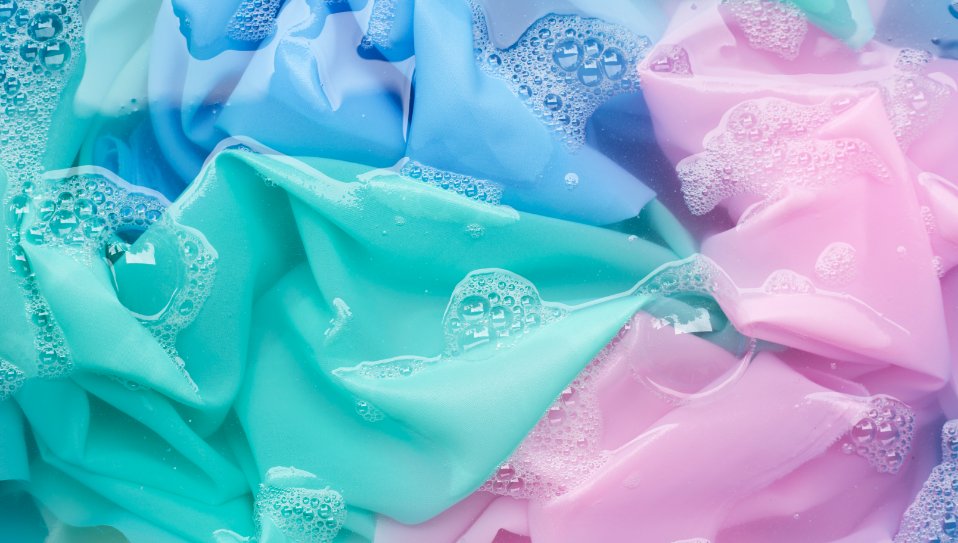
Hand Washing Techniques
Hand washing clothes helps protect delicate fabrics and extends the life of special garments. Proper hand washing techniques involve using the right water temperature and gentle movement to clean without damaging fibers.
For visual learners, Consumer Reports and major detergent brands like Tide regularly publish instructional videos showing proper hand washing techniques for delicate fabrics. These demonstrations can be particularly helpful for understanding the gentle motions needed for silk and wool care.
Gentle Detergent and Cool Water
Start by filling a clean sink or basin with cool water. The water should feel cool to the touch – around 65-75°F.
Add 1-2 teaspoons of mild detergent or soap designed for delicates. Avoid regular laundry detergents which can be too harsh.
Test the water-soap mixture by dipping a small corner of the garment. This checks for any dye bleeding or fabric reaction.
Submerging and Agitating
Fully submerge the garment in the soapy water. Gently squeeze the water through the fabric without wringing or twisting.
Move items like silk and wool through the water using light pressing motions. Avoid rubbing fabrics against each other.
Let items soak for 10-15 minutes. For heavily soiled areas, use fingertips to work the soap in with circular motions.
Drain the soapy water and rinse items under cool running water. Keep rinsing until the water runs clear with no soap bubbles.
Gently press out excess water. Never wring or twist delicate fabrics. Roll items in a clean white towel to remove moisture.
For visual learners who need step-by-step guidance, our Fabric Care Calculator provides detailed hand washing instructions customized for your specific fabric type, including recommended temperatures and techniques.
Machine Washing Strategies
Proper machine washing techniques help clothes last longer and stay in better condition. The right combination of wash cycle, water temperature, and cleaning products makes a big difference in fabric care.
Many washing machine manufacturers provide video guides for their specific models, showing how to select appropriate cycles for different fabric types. Check your washer’s brand website or YouTube channel for model-specific demonstrations.
Choosing the Correct Cycle
Different fabrics need specific wash cycles to prevent damage. Sturdy cotton and denim items can handle regular cycles with normal agitation.
Delicate items like silk and lace require gentle cycles with minimal agitation to avoid tears and stretching. The gentle cycle uses slower spin speeds and shorter wash times.
Common Wash Cycles:
- Normal: For sturdy everyday clothes
- Delicate/Gentle: For lightweight and fragile fabrics
- Heavy Duty: For very dirty items or heavy fabrics
- Quick Wash: For lightly soiled clothes
💻 Pro Tip: Not sure which cycle to choose? Our Fabric Care Calculator takes the guesswork out of washing by providing personalized instructions based on your exact fabric type.
Water Temperature Matters
Water temperature affects cleaning power and fabric care. Hot water cleans best but can damage or shrink sensitive materials.
Temperature Guidelines:
- Hot (130°F+): White cotton, heavily soiled items
- Warm (90°F): Most everyday clothes
- Cold (60-80°F): Dark colors, delicates
Cold water helps prevent color bleeding and saves energy. Modern detergents work well in all temperatures.
Is 30 Degrees a Cold Wash?
Yes, 30°C (86°F) is considered a cold wash. This temperature is ideal for dark colors, delicate fabrics, and preventing shrinkage while still providing effective cleaning.
What Fabrics Should You Not Wash Together?
Fabric Sorting Rules
Never mix these combinations:
- Heavy denim with delicate fabrics
- Dark colors with whites
- Lint-producing items (towels) with lint-attracting fabrics (corduroy)
- Items that shed (new fleece) with smooth fabrics
Fabric Weight Considerations
Lightweight fabrics can get damaged when washed with heavy items. The agitation can cause stretching, pilling, or tears.
Sort by weight:
- Lightweight: Silk, chiffon, thin cotton
- Medium weight: Regular cotton, polyester blends
- Heavy weight: Denim, thick sweaters, towels
What Fabrics Cannot Be Machine Washed?
Some fabrics require special care and should never go in a washing machine:
- Silk charmeuse (can lose its lustrous finish)
- Structured blazers with interfacing
- Leather and suede
- Items with metal embellishments
- Delicate vintage pieces
- Heavily beaded garments
Special Care for Delicate Fabrics
Proper care techniques help delicate garments maintain their beauty and shape. Using gentle washing methods and the right temperature prevents damage to fine fibers.
Washing Silk and Wool
Check garment labels carefully before washing silk or wool items. Use cool or lukewarm water – never hot water, as it can cause shrinking and damage.
Fill a clean sink with cool water and add a mild detergent made for delicate fabrics. Never use regular laundry detergent, as it’s too harsh.
Gently swish garments in the water for 2-3 minutes. Don’t twist, wring, or scrub the fabric.
Pat items dry with a clean towel and lay flat to dry. Keep wool and silk away from direct sunlight and heat.
Dealing with Lace and Embroidery
Inspect all delicate trim and stitching before washing. Look for loose threads or seams that could unravel.
Place lace and embroidered items in a mesh washing bag to prevent snags. Hand wash using cool water and gentle soap.
Support embroidered sections while washing to avoid stretching. Never wring or twist these items.
Lay items flat between two clean white towels and gently press to remove excess water. Reshape while damp and dry flat away from direct heat.
Smart Fabric Care Technology

Modern technology is revolutionizing how we care for fabrics. Smart washing machines now adjust cycles automatically based on fabric type and soil level.
AI-Powered Washing
New washing machines use sensors to detect fabric types and adjust water temperature, spin speed, and cycle time accordingly. This technology helps prevent damage while ensuring effective cleaning.
Eco-Friendly Innovations
Biodegradable detergents with enzyme-based formulas are gentler on fabrics while reducing environmental impact. These products effectively remove stains without harsh chemicals.
Cold-water detergents are specially formulated to work effectively at lower temperatures, saving energy while protecting temperature-sensitive fabrics.
Drying and Post-Wash Care
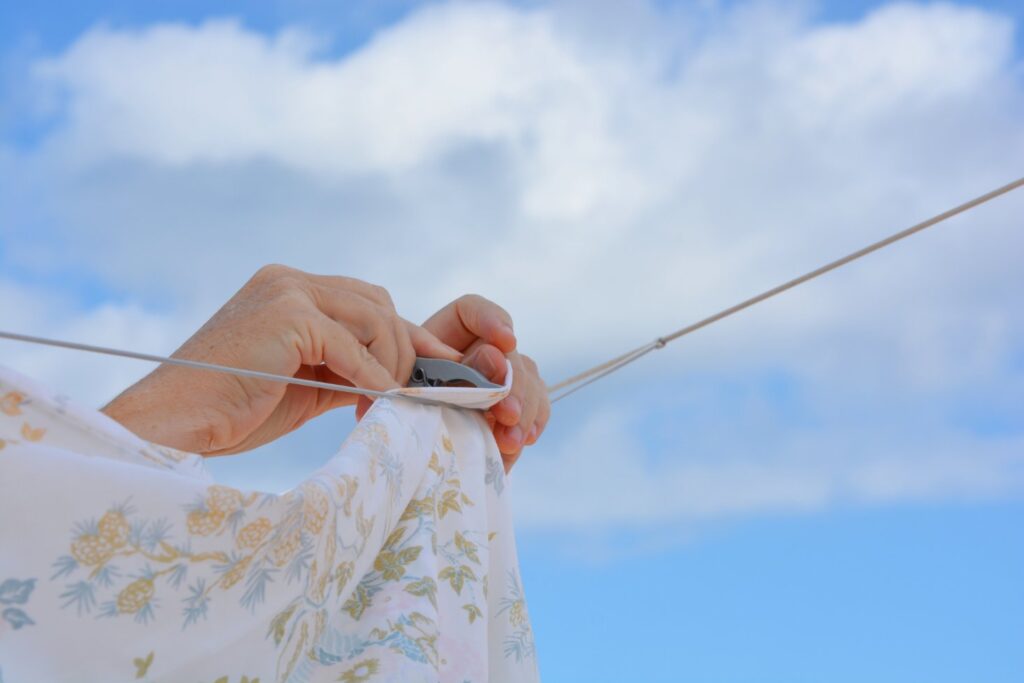
Proper drying methods keep clothes in good condition and prevent damage. Different fabrics need specific drying techniques to maintain their shape and quality.
Effective Air-Drying
Delicate garments need gentle handling when drying. Lay silk and wool items flat on a clean towel to maintain their shape.
Hang sturdy fabrics like cotton and denim on a clothesline or drying rack. Space items apart to allow air circulation.
Moisture-wicking athletic wear dries best on hangers. This prevents stretching and helps maintain the fabric’s breathable properties.
Avoid direct sunlight for dark colors to prevent fading. Place items in a shaded, well-ventilated area.
When to Tumble Dry
Set the dryer to low heat for most everyday items. High temperatures can damage elastic and cause shrinkage.
Use dryer balls to reduce static and wrinkles. They also help separate clothes for faster drying.
Cotton items can handle regular tumble drying. Remove them while slightly damp to prevent wrinkles.
Microfiber towels need low heat settings. High heat can melt the fibers and reduce absorbency.
Check care labels for temperature limits. Some items marked “tumble dry low” may still need special attention.
What Setting to Wash Bed Sheets?
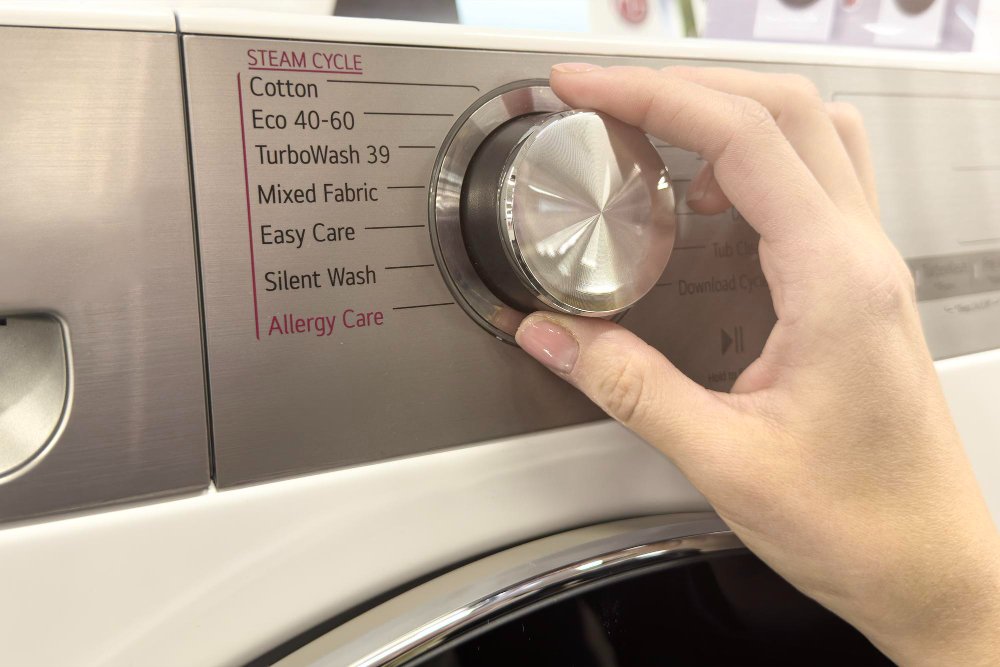
Bed sheets typically wash best on a normal cycle with warm water (about 104°F). Use a gentle detergent and avoid overloading the machine.
Sheet care tips:
- Wash sheets separately from other items
- Use the extra rinse cycle to remove all detergent
- Dry on medium heat and remove while slightly damp
- Wash weekly in hot water for deep cleaning
Ironing and Storage Solutions
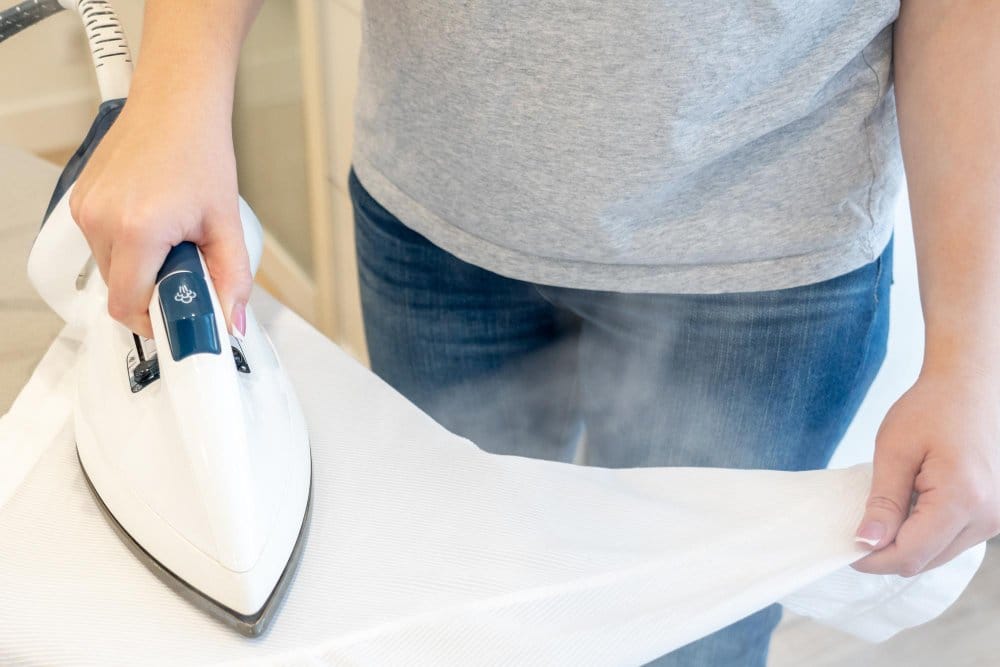
Proper ironing techniques and smart storage practices keep clothes looking pristine and extend their lifespan. The right temperature settings and storage methods prevent damage while maintaining fabric quality.
Ironing Different Fabric Types
Cotton fabrics need high heat and steam for best results. Iron while slightly damp and use a spray bottle if needed.
Dark cotton items should be ironed inside out to prevent shine marks. Start with collars and cuffs by pressing the underside first.
Delicate fabrics like silk require extra care. Use the lowest heat setting and avoid steam to prevent water spots.
Always check garment care labels before ironing. They provide essential information about temperature settings and steam requirements.
Should I Wash Jeans Inside Out?
Yes, washing jeans inside out protects the outer surface from fading and wear. This technique also prevents the hardware (buttons, rivets) from scratching other items in the wash.
Storing Fabrics to Prevent Damage
Fold knit items and sweaters to prevent stretching. Hang structured garments like suits and dresses on padded or wooden hangers.
Store clothes in a cool, dry place away from direct sunlight to prevent fading and color damage. Use breathable garment bags for special items.
Leave space between hanging items to prevent wrinkling and allow air circulation. This helps maintain fabric shape and prevents moisture buildup.
Clean clothes thoroughly before storage to prevent stains from setting. Remove dry cleaning bags as they can trap moisture and cause yellowing.
Understanding and Preventing Pilling
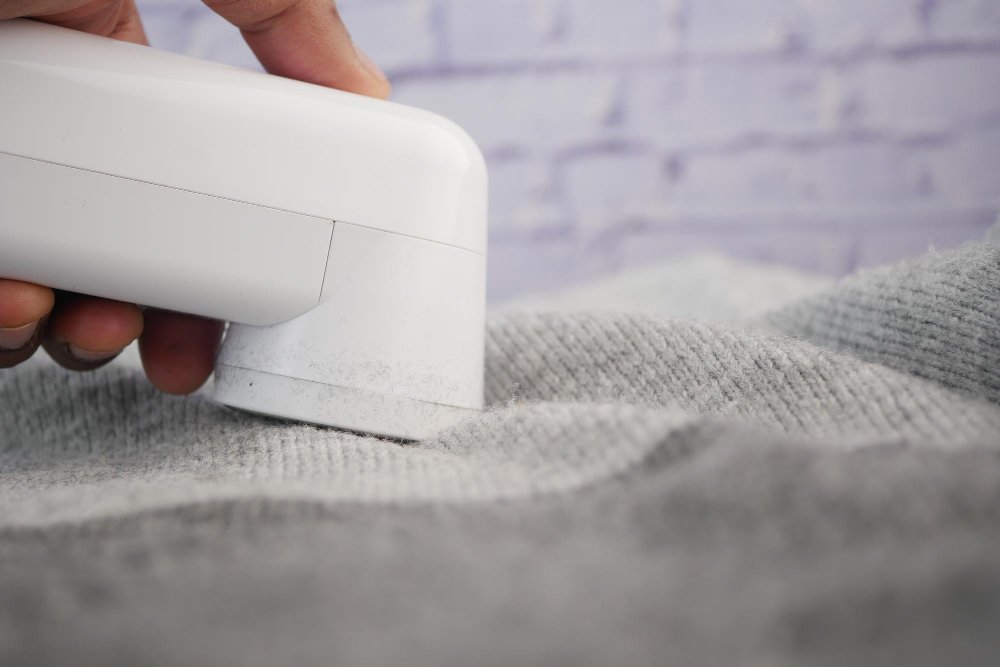
Pilling happens when loose fibers on fabric surfaces tangle and form small balls or knots. These fuzzy balls can make clothes look old and worn out fast.
Synthetic fabrics like polyester tend to pill more than natural materials. Fleece, acetate, and rayon are especially prone to pilling due to their fiber structure.
The way clothes are washed makes a big difference. Using the delicate cycle reduces fabric damage and pilling by limiting friction between clothes.
Key Prevention Tips:
- Turn clothes inside out before washing
- Use cold water and mild detergent
- Avoid overloading the washer
- Air dry when possible
Need help determining the right care approach for pill-prone fabrics? Our Fabric Care Calculator provides specific instructions for synthetic fabrics and blends that are most susceptible to pilling.
Proper fabric care starts with reading clothing labels. High heat in dryers can break down fibers and cause more pilling.
For clothes that already have pills, fabric shavers or sweater combs can remove them. Regular maintenance helps keep clothes looking new longer.
Pro tip: Separating rough fabrics like jeans from soft ones like sweaters during washing helps prevent excess friction and pilling.
Advanced Techniques and Tips
Modern fabrics need specialized care methods to maintain their unique properties. Some materials require extra attention to prevent damage and extend their lifespan.
Caring for High-Tech and Performance Fabrics
Microfiber items need special handling to maintain their dust-trapping abilities. Wash these fabrics separately from regular clothes to prevent lint transfer.
Skip fabric softeners and dryer sheets when washing performance wear. These products can create a coating that reduces moisture-wicking properties.
Temperature guidelines:
- Use cold water for synthetic blends
- Air dry or tumble dry on low heat
- Never use hot water settings
Important steps:
- Turn garments inside out
- Zip all zippers and close velcro straps
- Use gentle, fragrance-free detergent
Treating Specialty Fabrics Like Suede and Leather
Professional cleaning services are best for delicate materials like suede and velvet. These items can suffer permanent damage from regular washing.
Leather needs regular conditioning to prevent cracking. Apply leather conditioner every 3-6 months.
Daily care tips:
- Brush suede after each wear
- Wipe leather with a dry cloth
- Store in breathable garment bags
Remove stains quickly with specialized cleaning products made for each material type. Test cleaners on a hidden spot first.
How Often Should I Wash Certain Types of Clothes?
Different garments have varying washing frequency needs:
After every wear:
- Underwear and socks
- Workout clothes
- White dress shirts
After 2-3 wears:
- Dark jeans
- Casual shirts
- Blouses
After 4-5 wears:
- Sweaters
- Dress pants
- Skirts
Seasonal washing:
- Coats and jackets
- Formal wear
- Wool suits
The Good Housekeeping Institute Home Care & Cleaning Lab, with over 40 years of textile testing expertise, emphasizes that proper washing frequency not only maintains garment appearance but also extends fabric life significantly. Their research shows that overwashing can damage fibers and fade colors, making strategic timing essential for clothing longevity.
What Happens If You Accidentally Wash Dry Clean Only?
If you accidentally wash a dry-clean-only item:
- Don’t panic – assess the damage first
- Don’t put it in the dryer – heat will set any damage
- Reshape while damp and lay flat to dry
- Consider professional restoration for valuable items
Some items may survive with minimal damage, while others (like structured blazers) may be permanently altered.
How to Get Wrinkles Out of Dry Clean Only Clothes
For dry-clean-only items with wrinkles:
- Steam method: Hang in bathroom during hot shower
- Professional steaming: Take to dry cleaner for steaming service
- Wrinkle release spray: Use commercial products designed for delicates
- Gentle ironing: Use lowest heat with pressing cloth (test hidden area first)
Can You Dry Clean All Fabrics?
Not all fabrics are suitable for dry cleaning:
Safe for dry cleaning:
- Wool and wool blends
- Silk
- Acetate
- Rayon
- Structured garments
Not suitable:
- Rubber or plastic materials
- Items with sequins or beading (may dissolve)
- Water-repellent fabrics (may lose coating)
- Some synthetic elastics
What’s the Difference Between Easy Care and Delicates?
Easy Care fabrics:
- Can handle regular machine washing
- Wrinkle-resistant properties
- Quick-drying
- Examples: Cotton blends, polyester
Delicate fabrics:
- Require gentle handling
- Special washing instructions
- Often need hand washing or dry cleaning
- Examples: Silk, lace, cashmere
Fabric Care Troubleshooting Guide
Common Problems and Solutions
| Problem | Cause | Solution |
|---|---|---|
| Shrinkage | Hot water/high heat | Use cool water, air dry |
| Color bleeding | Hot water, mixed colors | Sort properly, use cold water |
| Pilling | Friction, synthetic fibers | Turn inside out, gentle cycle |
| Static cling | Over-drying, synthetic fabrics | Use dryer balls, reduce dry time |
| Fading | Hot water, direct sunlight | Wash in cold water, dry in shade |
Interactive Problem Solving
For complex fabric care challenges, our specialized tools provide targeted solutions:
🧮 Fabric Care Calculator – Input your fabric type for personalized washing instructions
🔍 Stain Removal Guide – Step-by-step troubleshooting for any stain type
🏷️ Care Symbol Decoder – Instantly understand any garment care label
These tools complement the information in this guide and provide interactive assistance for specific situations.
Eco-Friendly Fabric Care Practices
Sustainable Washing Tips
- Wash full loads to maximize water and energy efficiency
- Use cold water when possible to save energy
- Line dry to reduce energy consumption and extend fabric life
- Choose concentrated detergents to reduce packaging waste
Green Alternatives
- White vinegar as fabric softener (1/2 cup in rinse cycle)
- Baking soda for odor removal and gentle cleaning
- Wool dryer balls instead of dryer sheets
- Plant-based detergents for sensitive skin and environment
Cost-Saving Fabric Care Tips
Proper fabric care saves money long-term:
- Pre-treat stains immediately to avoid permanent damage
- Rotate clothing to prevent excessive wear
- Store seasonal items properly to maintain condition
- Invest in quality hangers to preserve garment shape
- Follow care instructions to avoid costly replacements
Frequently Asked Questions
How do I sort laundry by fabric type?
Create separate piles for:
• Delicates: Silk, lace, fine knits
• Cotton and linens: Sturdy natural fibers
• Synthetics: Polyester, nylon, acrylic
• Heavy items: Jeans, towels, thick sweaters
• Mixed blends: Follow care of most delicate fiber
Can I use delicate cycle for everything?
While the delicate cycle is gentler, it’s not always the best choice:
• Good for: Delicate fabrics, lightly soiled items
• Not ideal for: Heavily soiled clothes, sturdy fabrics that need agitation
• Consider: Longer wash times and potentially less effective cleaning for tough stains
What is the gentle cycle on a washing machine?
The gentle cycle uses:
• Slower agitation speeds
• Shorter wash times
• Reduced spin speeds
• Often cooler water temperatures
• Less mechanical action to protect delicate fabrics
What fabrics should you stay away from?
Consider avoiding:
• High-maintenance fabrics if you prefer easy care
• Dry-clean-only items for everyday wear
• Fabrics that pill easily for high-wear items
• White fabrics if you’re prone to stains
• Delicate materials for children’s clothing
What is the easiest fabric to keep clean?
Polyester blends are typically easiest to maintain:
• Machine washable
• Wrinkle-resistant
• Quick-drying
• Stain-resistant
• Durable construction
Cotton is also very manageable for everyday care.
What two fabrics should not be mixed?
Critical combinations to avoid:
• Lint producers (towels) with lint attractors (corduroy)
• Heavy denim with delicate silks
• New dark items with light colors
• Water-repellent items with absorbent fabrics
What tools can help me with fabric care decisions?
We’ve created three interactive tools to make fabric care easier:
• Fabric Care Calculator: Get personalized washing instructions for any fabric type
• Stain Removal Guide: Interactive troubleshooting for effective stain treatment
• Care Symbol Decoder: Visual tool for interpreting garment care labels
These free tools provide instant, specific guidance for your fabric care challenges.
Seasonal Fabric Care Considerations
Summer Care Tips
- Increase washing frequency due to perspiration
- Use lighter detergents for delicate summer fabrics
- Air dry outdoors when possible for fresh scent
- Protect colors from intense UV rays
Winter Care Tips
- Layer protection for wool and cashmere items
- Indoor drying may require longer times
- Static control becomes more important in dry air
- Storage preparation for summer clothes
Professional vs. DIY Care
When to Choose Professional Cleaning
Always professional:
- Wedding dresses and formal wear
- Leather and suede items
- Heavily beaded or sequined garments
- Vintage or antique textiles
- Items with complex construction
DIY-Friendly Items
Safe for home care:
- Most cotton and polyester items
- Casual clothing
- Everyday synthetic blends
- Athletic wear
- Basic wool knits (with proper care)
Technology Integration in Fabric Care
Smart Washing Features
Modern appliances offer:
- Fabric detection sensors
- Automatic cycle adjustment
- Load size optimization
- Temperature control
- Mobile app connectivity
Future Innovations
Emerging technologies include:
- Self-cleaning fabrics
- Antimicrobial treatments
- Smart fibers that indicate washing needs
- Nano-coatings for stain resistance
Conclusion
Proper fabric care is both an art and a science that requires understanding your textiles, following care instructions, and using the right techniques for each material. The investment you make in learning proper fabric care pays dividends through longer-lasting clothes, better appearance, and significant cost savings over time.
The key takeaways for successful fabric care include always reading and following care labels, sorting laundry appropriately by both color and fabric type, using the correct water temperature and wash cycles, and choosing proper drying methods. Remember that different fabrics have unique needs – what works for cotton may damage silk, and what preserves wool might not be suitable for synthetic performance fabrics.
As fabric technology continues to evolve with smart textiles, antimicrobial treatments, and eco-friendly innovations, staying informed about new care methods becomes increasingly important. The integration of AI-powered washing machines and sustainable cleaning products offers exciting opportunities to improve fabric care while reducing environmental impact.
To make implementing these fabric care principles even easier, we’ve developed interactive tools that provide personalized guidance. Our Fabric Care Calculator offers customized washing instructions, while our Stain Removal Guide provides step-by-step troubleshooting for any stain emergency. For those confusing care labels, our Care Symbol Decoder instantly explains what each symbol means.
Essential recommendations for long-term fabric care success:
- Create a fabric care routine that includes regular inspection, proper sorting, and immediate stain treatment
- Invest in quality tools like mesh washing bags, wool dryer balls, and appropriate detergents for different fabric types
- Stay organized with clear storage systems and seasonal wardrobe rotation
- Learn from experience by keeping notes on what works best for your specific garments
- Consider professional help for valuable or complex items rather than risking damage
Cost-saving strategies that make a real difference:
Regular maintenance prevents costly replacements, proper storage preserves garment quality, and following manufacturer instructions avoids damage that requires professional restoration. The time you spend learning proper fabric care techniques will save you money and keep your wardrobe looking its best for years to come.
Looking ahead to the future of fabric care:
As sustainability becomes increasingly important, focus on eco-friendly practices like cold-water washing, line drying when possible, and choosing biodegradable detergents. These practices benefit both your clothes and the environment while often reducing utility costs.
Remember that fabric care is an ongoing learning process. As you encounter new materials and garments, apply these fundamental principles while staying open to adjusting your methods based on results. With consistent application of proper techniques, your clothes will maintain their appearance, fit, and quality far longer than with careless handling.
The intersection of technology and traditional fabric care offers promising developments for the future. Smart washing machines, advanced detergent formulations, and innovative fabric treatments continue to make proper care easier and more effective. By staying informed about these developments while maintaining strong foundational knowledge, you’ll be well-equipped to care for any textile that comes your way.


